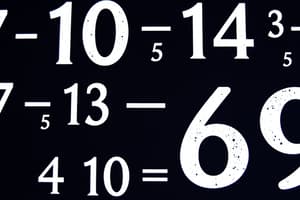Podcast
Questions and Answers
What is the first step required when adding rational numbers?
What is the first step required when adding rational numbers?
- Simplify the fraction
- Find a common denominator (correct)
- Convert fractions to decimals
- Multiply the numerators together
When dividing one rational number by another, what operation should be performed on the second fraction?
When dividing one rational number by another, what operation should be performed on the second fraction?
- Multiply it by its reciprocal (correct)
- Convert it to a decimal
- Add it to the first fraction
- Subtract it from the first fraction
Which of the following accurately describes zero in terms of rational numbers?
Which of the following accurately describes zero in terms of rational numbers?
- Neither positive nor negative (correct)
- Always the smallest rational number
- Greater than positive rational numbers
- Less than negative rational numbers
In comparing rational numbers, which method allows for meaningful comparisons?
In comparing rational numbers, which method allows for meaningful comparisons?
What is the result of multiplying two rational numbers together?
What is the result of multiplying two rational numbers together?
Which of the following numbers is not a rational number?
Which of the following numbers is not a rational number?
What property ensures that the sum of any two rational numbers is also a rational number?
What property ensures that the sum of any two rational numbers is also a rational number?
Which fraction represents the repeating decimal 0.666...?
Which fraction represents the repeating decimal 0.666...?
Which of the following describes the identity element for multiplication in rational numbers?
Which of the following describes the identity element for multiplication in rational numbers?
What is the multiplicative inverse of the rational number 4?
What is the multiplicative inverse of the rational number 4?
What characteristic distinguishes terminating decimals from repeating decimals?
What characteristic distinguishes terminating decimals from repeating decimals?
Which mathematical operation cannot be performed on rational numbers involving a zero divisor?
Which mathematical operation cannot be performed on rational numbers involving a zero divisor?
Which of the following best describes the relationship between rational and irrational numbers?
Which of the following best describes the relationship between rational and irrational numbers?
Flashcards
Rational Numbers
Rational Numbers
Numbers that can be expressed as a fraction, where the numerator and denominator are integers, and the denominator is not zero.
Adding Rational Numbers
Adding Rational Numbers
Adding rational numbers requires finding a common denominator, then adding the numerators. Simplify if possible.
Subtracting Rational Numbers
Subtracting Rational Numbers
Subtracting rational numbers is similar to addition, but you subtract the numerators.
Multiplying Rational Numbers
Multiplying Rational Numbers
Signup and view all the flashcards
Dividing Rational Numbers
Dividing Rational Numbers
Signup and view all the flashcards
Closure under addition (Rational Numbers)
Closure under addition (Rational Numbers)
Signup and view all the flashcards
Closure under subtraction (Rational Numbers)
Closure under subtraction (Rational Numbers)
Signup and view all the flashcards
Closure under multiplication (Rational Numbers)
Closure under multiplication (Rational Numbers)
Signup and view all the flashcards
Closure under division (Rational Numbers)
Closure under division (Rational Numbers)
Signup and view all the flashcards
Commutative Property (Rational Numbers)
Commutative Property (Rational Numbers)
Signup and view all the flashcards
Associative Property (Rational Numbers)
Associative Property (Rational Numbers)
Signup and view all the flashcards
Distributive Property (Rational Numbers)
Distributive Property (Rational Numbers)
Signup and view all the flashcards
Study Notes
- Rational numbers are numbers that can be expressed as a fraction p/q, where p and q are integers and q is not equal to zero.
- This includes integers (e.g., 3, -5, 0), fractions (e.g., 1/2, 3/4, -2/5), terminating decimals (e.g., 0.75, -2.5), and recurring decimals (e.g., 0.333...).
- Recurring decimals can be expressed as fractions (e.g., 0.333... = 1/3).
Key Properties of Rational Numbers
- Closure under addition: The sum of any two rational numbers is a rational number.
- Closure under subtraction: The difference of any two rational numbers is a rational number.
- Closure under multiplication: The product of any two rational numbers is a rational number.
- Closure under division (excluding division by zero): The quotient of any two rational numbers (with the divisor not being zero) is a rational number.
- Commutative property: Addition and multiplication are commutative for rational numbers. (a + b = b + a and a * b = b * a)
- Associative property: Addition and multiplication are associative for rational numbers. ((a + b) + c = a + (b + c) and (a * b) * c = a * (b * c))
- Distributive property: Multiplication distributes over addition for rational numbers. a * (b + c) = (a * b) + (a * c)
- Identity elements: 0 is the additive identity (a + 0 = a) and 1 is the multiplicative identity (a * 1 = a).
- Inverse elements: Every rational number has an additive inverse (opposite) and every non-zero rational number has a multiplicative inverse (reciprocal).
Representing Rational Numbers
- Decimal representation: Rational numbers can be represented as decimals. These decimals can either terminate (e.g., 0.75) or repeat (e.g., 0.333...). Terminating decimals have a finite number of digits after the decimal point, while repeating decimals have a repeating pattern of digits after the decimal point.
- Fraction representation: Rational numbers are inherently represented as fractions. This form emphasizes the relationship between the parts (numerator) and the whole (denominator).
Relationship to Irrational Numbers
- Irrational numbers cannot be expressed as a fraction of two integers.
- Examples of irrational numbers include π (pi) and the square root of 2.
- The set of rational numbers and the set of irrational numbers together form the set of real numbers.
Importance in Mathematics
- Fundamental concept in arithmetic and algebra.
- Basis for many mathematical operations and theories.
- Crucial for understanding and working with various mathematical concepts like ratios and proportions.
- Used extensively in practical applications, including measurements, calculations, and modeling.
Operations with Rational Numbers
- Addition: Find a common denominator, add the numerators, simplify if needed.
- Subtraction: Similar to addition, find a common denominator, subtract the numerators, simplify if needed.
- Multiplication: Multiply the numerators together and the denominators together, simplify if needed.
- Division: Multiply the first fraction by the reciprocal of the second fraction, simplify if needed.
Comparison of Rational Numbers
- Ordering rational numbers: Convert fractions to decimals to compare, or find a common denominator. This allows for meaningful comparisons based on size or value. Positive rational numbers are greater than zero, negative rational numbers are less than zero and zero is considered neither positive nor negative.
Studying That Suits You
Use AI to generate personalized quizzes and flashcards to suit your learning preferences.




